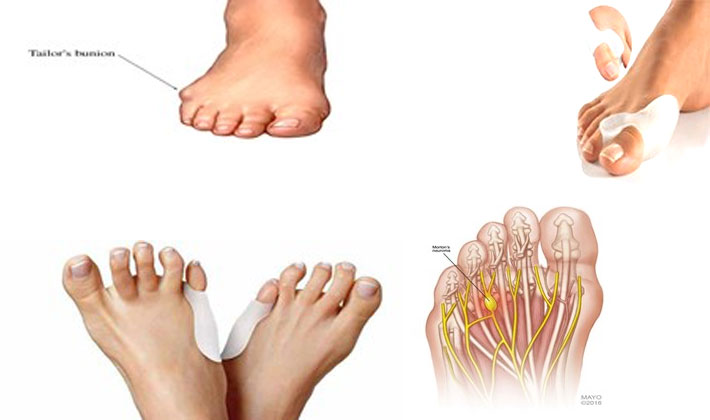Don’t neglect your toes just because they’re small. The following common types of toe pain can worsen if not treated.
Mortons neuroma:
Tingling, Numbing or Burning Sensation in the Toes

Mortons neuroma is a painful condition that can be described as a tingling, numbing or burning sensation in the toes. Commonly people who have this condition report that they have “shocks” in the foot as they walk. There are 4 arches in the foot and when the one at the ball of the foot collapses, the toe bones tend to rub on the nerve tissue and the shock results when the toe bones rub on the nerve. When the nerves do not have enough room, they become pinched and then become angry and inflamed. This becomes an easier target for the bones to rub on the nerve and a cycle begins where irritation causes the inflammation, burning pain, and the inflammation increases the ability to irritate the nerve.
You may also have the sensation of walking on a pebble or a balled up sock. Shoes that squeeze the toes can be to blame. This doesn’t mean that only high heeled shoes are the culprits. Many people may wear their shoes too tight or wear the incorrect width and that creates squeezing of the forefoot.
Mortons neuroma will get progressively worse and it is important to treat the issue before you experience nerve damage that cannot heal on its own. When caught early, conservative treatments tend to work very well. Metatarsal pads of a specific shape help to support the arch that runs across the front of the foot and this helps to open up the space where the nerve is being pinched. Metatarsal pads can be incorporated in to off the shelf insoles or custom orthotics. It is very important that you are wearing shoes that fit properly and that do not squeeze the front of the foot.

Bunionettes, Bunions and Hallux valgus
A bunionette or tailor’s bunion is an enlargement of the baby toe joint as seen on the right.
A Bunion is a bony enlargement or bump located on the side of the big toe joint. The areas affected by the enlargement are often irritated and made more painful by tight fitting shoes which cause pressure and friction on the area. Having shoes that are wide enough at the ball of the foot is an important way to reduce the irritation caused by rubbing on one side or the other.
Symptoms of bunions include redness and swelling in the area and may also have a shift of the big toe toward the smaller toes. This is called a Hallux Valgus deformity. This shift to the smaller toes is often improperly identified as a bunion, but frequently co-exists with a bunion
Overpronation, heredity and poor fitting shoes are often factors in the cause of bunions as well as hallux valgus. It was believed that wearing high heeled shoes with pointed toes was the only cause of these, but there are more causes than that. The various causes can combine to make a worse presentation.
The hallux valgus deformity is aggravated by increased foot pressure put on the big toe. Custom orthotics can help to reduce excess motion in the middle of the foot and work to evenly distribute forefoot pressure.

For both bunionettes and bunions, having a shoe with a wide enough area at the toes will help give relief to the area and help stop the irritation.
For bunionettes, wearing shields like the ones pictured at the right are ways to help reduce the pain and irritation in that area.

Bunion night splints and aligners along with custom made toe spacers are excellent options to help treat pain caused by bunions. At the left is an example of a bunion shield and a toe spacer combination.
The goal of a Canadian Certified Pedorthist is to help you to be more active and to help reduce any pain that you may experience. If you have any questions about these conditions and what can be done to help you, please contact your local Pedorthist. You can find your nearest Pedorthist here.
By Jim Pattison C. Ped (C)
